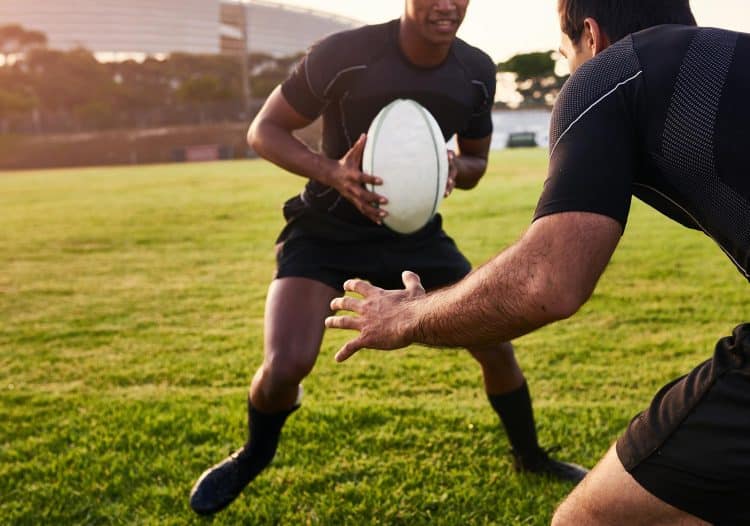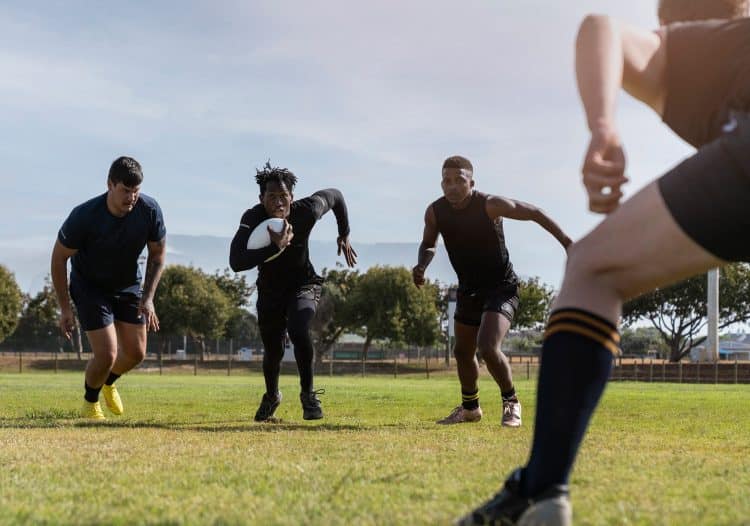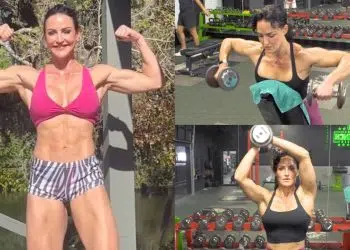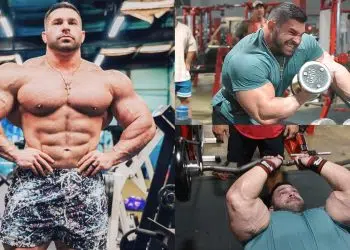Rugby is a physically demanding sport that requires a high fitness level to perform at a competitive level. It demands a good balance of aerobic and anaerobic fitness, strength, power, and agility.
Rugby requires players to have a high cardiovascular fitness and endurance level to sustain their efforts for the entire game. It also requires speed, agility, and the ability to quickly generate a lot of force, which depends on anaerobic fitness.
You need a program that develops strength, explosive power, and speed to excel in this sport.
As a personal trainer living in New Zealand (home of the famed All Blacks), I’ve been training rugby players for decades. In this article, I’ll outline the ultimate rugby workout to help you excel on the field.
The Energy Systems That Power a Rugby Player
Jumping in the line-out and tackling opponents demands instant energy, which puts pressure on the ATP-CP system. You need aerobic endurance to handle these demands.
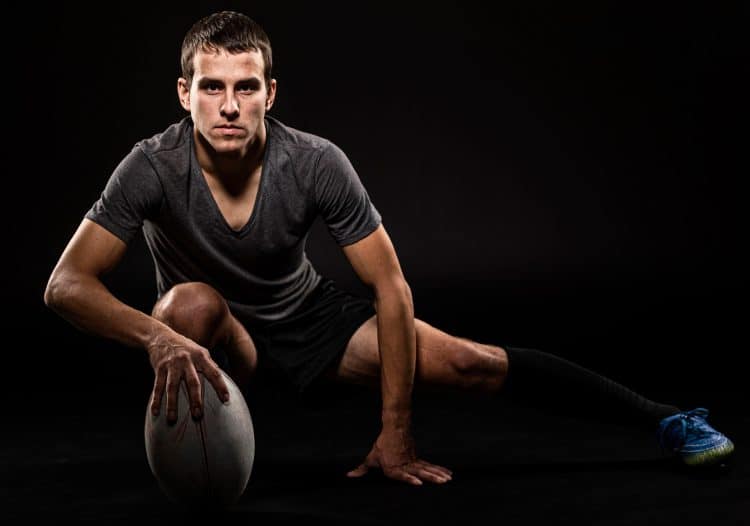
Level Up Your Fitness: Join our 💪 strong community in Fitness Volt Newsletter. Get daily inspiration, expert-backed workouts, nutrition tips, the latest in strength sports, and the support you need to reach your goals. Subscribe for free!
Your aerobic energy requirements will vary based on your position.
Forward Position Aerobic Energy Demands
The forward positions in rugby, such as prop, lock, and flanker, have high aerobic energy demands due to the nature of the game and the specific roles of these positions.
Forwards are often involved in scrums, rucks, and mauls, which involve a lot of pushing and shoving. These activities require a high level of cardiovascular fitness and endurance to sustain the effort for the entire game.
In addition, forwards are also typically involved in a lot of running and tackling, which further increases the aerobic energy demands of the position. These activities require players to have a high level of cardiovascular fitness to recover quickly after intense bursts of activity and maintain a high level of performance throughout the game.
As a result, forwards need to have a high level of aerobic fitness to perform at their best during the game. This includes the ability to run for long periods, as well as the ability to recover quickly after intense bursts of activity.
Back Position Aerobic Energy Demands
The back positions in rugby, such as scrum-half, fly-half, center, and wing, also have high aerobic energy demands.
Backs are often involved in running and passing plays, which require a lot of sprinting and changing direction. These activities require a high level of cardiovascular fitness and endurance. Backs also need to have a high level of speed and agility, which is highly dependent on good aerobic fitness.
Additionally, backs are typically involved in a lot of tackling, which further increases the aerobic energy demands of the position. These activities require a high level of cardiovascular fitness to recover quickly after intense bursts of activity and maintain a high level of performance throughout the game.
Anaerobic Energy Demands
Short, intense bursts of activity, such as sprinting, tackling, and rucking, use anaerobic energy. These activities require players to generate a lot of force quickly, which is dependent on the player’s anaerobic fitness. [1]
The scrums, rucks, and mauls that forwards are involved in also require a high anaerobic fitness level. These activities involve a lot of pushing and shoving and require players to generate a lot of force quickly.
In addition, backs need to have a high anaerobic fitness level to perform at their best during the game. This includes accelerating quickly, changing direction rapidly, and maintaining high speed during short bursts of activity.
In summary, rugby players must have a good balance of aerobic and anaerobic fitness to perform at their best during the game.
Off-Season Rugby Training
The off-season is the ideal time to add muscle, increase your strength, and develop explosive power. Four-week off-season routines help increase absolute strength and explosive power. Exercises one and three will help you gain size and strength, whereas exercises two and four will build power.
Although you’ll spend considerable time in the gym during the off-season, you should also hone your on-field skills. To do this, include some rugby-specific drills 2-3 times per week.
Off-Season Strength Training Principles
Strength training focuses on increasing the maximum force that a muscle can produce. The goal is to make the muscle bigger and stronger to handle heavier loads.
- Build your workout around compound exercises: Compound exercises target multiple muscle groups. Squats, bench presses, and lat pulldowns are a few examples. Compound exercises are effective for increasing strength and size. [2]
- Focus on proper exercise technique: Use the correct form while exercising for the best effects. Give the eccentric phase of the lift at least two seconds and the concentric phase one second.
- Use a pyramid rep system: With this technique, the weights increase between sets as the reps decrease.
- Heavy weight, low reps: The most effective way to gain strength and size is to work to failure with lower reps and heavier weights. Use the heaviest weights you can while still maintaining proper form. Lift weights that are at least 85% of your one-rep maximum for best results. [3]
- Breathe properly: Don’t hold your breath at any time during your workout, as it can stop blood flow to your heart and brain. You should inhale on the eccentric part of the rep and exhale on the concentric portion.
- Rest for longer between sets: You’ll experience muscle exhaustion while lifting heavy weights and need longer breaks between exercises. In most cases, two to five minutes between sets are sufficient for rest.
Off-Season Explosive Power Training Principles
Power training focuses on increasing the rate at which a muscle can produce force. The goal is to make the muscle more explosive and able to generate greater force quickly. Repetitions are typically performed explosively and with lighter loads.
- 1-5 rep range: This is the best rep range for explosive power training. This rep range is optimal for developing power because it allows heavy load use, which is necessary for stimulating the fast-twitch muscle fibers responsible for explosive movements. When training for explosive power, it’s important to use loads that are heavy enough to challenge you but not so heavy that you can’t perform the exercises with proper form and explosiveness. The focus should be on moving the weight as fast as possible instead of lifting the heaviest weight possible.
- Increase speed and intensity: Power training involves increasing the speed of your lifts. You should speed up the concentric portion of the lift before increasing weights. [4]
- Good form: Similar to strength training, the weight should be lowered gradually over at least two seconds. But you should raise the weights as quickly and explosively as possible when power training. This activates your fast-twitch muscle fibers, increasing the speed at which your muscles can contract and move. However, you should never sacrifice technique for speed.
- Choose exercises that promote explosive power: You should perform certain exercises quickly and intensely. Examples include body weight exercises like dips and pull-ups, as well as Olympic lifts like push presses and power cleans.
Rugby Off-Season Workout Program
This four-week off-season program has you focusing on strength and size during weeks one and three and explosive power in weeks two and four. You should repeat this four-week cycle throughout your off-season. Between each monthly cycle, however, take a whole week off from the gym to allow your body to recover before the next cycle.
Strength and Size Week One & Three:
Monday & Wednesday Workout
| Muscle Group | Exercise | Sets | Reps |
| Chest | Incline dumbbell bench press | 3 | 10, 10, 10 |
| Chest | Push-up | 3 | As many as possible |
| Shoulders | Push press | 3 | 10, 10, 10 |
| Shoulders | Barbell shrug | 3 | 10, 10, 10 |
| Triceps | Triceps kickback | 3 | 15, 15, 15 |
| Triceps | Bench dips | 3 | As many as possible |
Tuesday & Thursday Workout
| Muscle Group | Exercise | Sets | Reps |
| Legs | Calf raise | 3 | 20, 20, 20 |
| Legs | Box jumps | 3 | 12, 12, 12 |
| Legs | Jump squat | 3 | 12, 12, 12 |
| Back | Close-grip pull-up | 3 | As many as possible |
| Back | Bent-over barbell row | 3 | 12, 12, 12 |
| Biceps/ forearms | Reverse curl | 3 | 15, 15, 15 |
Explosive Power: Weeks Two & Four
Monday & Wednesday Workout
| Muscle Group | Exercise | Sets | Reps |
| Chest | Barbell bench press | 5 | 5,4,3,2,1 |
| Chest | Incline fly | 4 | 8,8,6,6 |
| Shoulders | Barbell military press | 5 | 8,6,4,2,1 |
| Shoulders | Upright row | 4 | 6,6,6,6 |
| Triceps | Triceps push down | 4 | 8,8,8,8 |
| Triceps | Overhead triceps extension | 4 | 8,8,8,8 |
Tuesday & Thursday Workout
| Muscle Group | Exercise | Sets | Reps |
| Chest | Squat | 5 | 10,8,6,4,2 |
| Chest | Deadlift | 4 | 10,8,6,4,2 |
| Shoulders | Leg curl | 4 | 8,8,6,4 |
| Shoulders | Close-grip pull-up | 4 | 8,8,6,6 |
| Triceps | Seated cable row | 4 | 8,8,6,6 |
| Triceps | Reverse curl | 4 | 8,8,8,8 |
When to Increase Weights
There are three ways to progressive overload:
- Using heavier weights
- Upping the number of repetitions
- Using advanced training techniques like supersets and dropsets
I recommend following the X + 3 method to increase your reps and poundage. Start with a weight that allows you to achieve your targeted rep count. Now set the goal of doing one more rep while maintaining proper form. Repeat this until you can do three more reps than your original rep count.
Level Up Your Fitness: Join our 💪 strong community in Fitness Volt Newsletter. Get daily inspiration, expert-backed workouts, nutrition tips, the latest in strength sports, and the support you need to reach your goals. Subscribe for free!
Pre-Season Rugby Training
Your pre-season training should begin five weeks from the start of the season. You should be bursting with strength and explosive power when you get on the field for your first game.
The preseason workout will help progress you from the off-season and make you strong for the season.
You should adjust your rep cadence during this training phase to achieve peak explosiveness and speed. Perform the eccentric portion of the lift slowly and smoothly. Complete the concentric portion of the rep quickly, intensely, and explosively for maximum power.
As the week progresses, the weights will get heavier, and the reps will decrease. This type of training combines strength and power.
In this program, you will train on a two-day workout split for four days per week. Here’s what the set and rep scheme looks like each week:
- Weeks 1 & 2: 10 reps
- Weeks 3 & 4: 8 reps
- Week 5: 6 reps
Monday Workout
| Muscle Group | Exercise | Sets |
| Chest | Barbell bench press | 4 |
| Chest | Incline barbell bench press | 3 |
| Shoulders | Barbell military press | 4 |
| Shoulders | Push press | 3 |
| Triceps | Tricep pushdown | 4 |
| Triceps | Overhead tricep extension | 4 |
Tuesday Workout
| Muscle Group | Exercise | Sets |
| Legs | Squat | 4 |
| Legs | Power clean | 3 |
| Legs | Calf raise | 4 |
| Back | T-bar row | 3 |
| Back | Bent over barbell row | 3 |
| Biceps | Barbell curl | 3 |
Thursday Workout
| Muscle Group | Exercise | Sets |
| Chest | Barbell bench press | 4 |
| Chest | Incline fly | 3 |
| Shoulders | Upright row | 4 |
| Shoulders | Dumbbell shrug | 3 |
| Triceps | Tricep pushdown | 4 |
| Triceps | Skull crusher | 4 |
Friday Workout
| Muscle Group | Exercise | Sets |
| Legs | Squat | 4 |
| Legs | Leg curl | 3 |
| Legs | Seated calf raise | 4 |
| Back | Seated cable row | 3 |
| Back | One-arm dumbbell row | 3 |
| Biceps | Preacher curl | 3 |
In-Season Gym Training for Rugby
During the rugby season, you should cut back to two workouts per week. Your goal is to maintain the strength, power, speed, and agility you have developed during the off and pre-seasons. Do these sessions on days you are not training with your team.
I recommend having an even week and an off-week workout that you alternate between.
I recommend having two different workouts during the in-season; Workout A and Workout B. You will alternate workouts from week to week.
In-season Workout A
| Muscle Group | Exercise | Sets | Reps |
| Legs | Squat | 4 | 10,8,6,4, |
| Chest | Barbell bench press | 4 | 10,8,6,4, |
| Shoulders | Barbell military press | 3 | 10,10,10 |
| Back | Bent-over barbell row | 3 | 12,10,10 |
| Biceps/Forearms | Hammer curl | 3 | 15,15,15 |
| Triceps | Triceps pushdown | 3 | 12,12,12 |
In-season Workout B
| Muscle Group | Exercise | Sets | Reps |
| Legs | Lunge | 4 | 10,8,6,4, |
| Chest | Dumbbell bench press | 4 | 10,8,6,4, |
| Shoulders | Dumbbell military press | 3 | 10,10,10 |
| Back | Seated cable row | 3 | 12,10,10 |
| Biceps/Forearms | Reverse curl | 3 | 15,15,15 |
| Triceps | Triceps kickback | 3 | 12,12,12 |
Rugby Cardio
Although strength, power, and explosiveness are essential for success on the rugby field, they won’t do you much good if you aren’t aerobically fit.
Aerobic conditioning is essential for rugby as it helps players maintain their endurance throughout the game. Rugby is a physically demanding sport that requires players to have a high level of cardiovascular fitness to perform at their best for the entire game.
This includes the ability to run for long periods, as well as the ability to recover quickly after intense bursts of activity. Aerobic conditioning can also help to reduce the risk of injury.
You’ll be on the field for 80 minutes unless subbed. To perform at your best, you’ve got to put in the hard work in your cardio endurance and stamina training.
Your cardio training should involve low-intensity steady-state training for aerobic endurance and high-intensity interval training for anaerobic fitness.
Endurance Cardio
To build your cardio endurance, I recommend doing a couple of 5-7 mile runs per week. Do them at a moderate pace that allows you to converse while running.
Another option is to jump on a rowing machine. Many coaches prefer to have their players do endurance work on a rower because they’re less likely to injure themselves. Rowing is a closed chain exercise where your feet never come off the foot platform. That means that there is no stress impact on the lower body joints. [5]
Rowing also works the upper and lower body muscles. You’ll engage your lats, shoulders, arms, and core, along with your quads, hamstrings, and glutes.
HIIT Cardio
You should do a couple of high-intensity interval training (HIIT) sessions per week to develop explosive speed and anaerobic fitness. HIIT is all about working hard and fast. Your HIIT sessions should last less than 10 minutes.
I recommend doing your HIIT workouts in an open field. You’ll be doing Tabata-style HIIT, which involves eight rounds of 20-second sprints with 10-second rests between sets. You will start with a two-minute warm-up and end with a two-minute cooldown. [6]
You will need a stopwatch for this workout.
Here is what the Tabata cardio routine will look like:
- Jog up and down the field for two minutes. From one minute thirty seconds onward, begin building your pace so that you are sprinting as soon as you hit the two-minute mark. Imagine bolting for the try line to score the game-winner. Sprint for 20 seconds.
- Recover for 10 seconds. You can stand still or walk.
- Sprint for another 20 seconds.
- Alternate between sprints and recoveries for eight rounds.
- Warm down with a two-minute jog.
Rugby Terms Defined
Here are a few rugby jargons, along with their meanings:
- Scrum: A method of restarting play in which the forwards from each team bind together in three rows and push against each other to try and gain possession of the ball.
- Ruck: A situation in which one or more players from each team are close around the ball.
- Maul: A situation where one or more players from each team are on their feet close to a player carrying the ball.
- Lineout: A method of restarting play where the ball is thrown from the touchline toward the midfield by a player from the team that did not touch the ball last.
- Tackling: The act of bringing a player carrying the ball to the ground.
- Conversion: A kick taken after a try (a score) is scored.
- Penalty kick: A kick taken by a team due to a penalty awarded by the referee.
- Drop goal: A kick taken during open play, which scores three points if it goes over the crossbar and between the goalposts.
- Try: The primary way of scoring in rugby, worth five points, is scored by a player grounding the ball in the opponent’s in-goal area.
- Knock-on: A situation in which a player loses control of the ball, and it goes forward, either deliberately or accidentally.
- Offside: A situation in which a player is closer to an opponent’s goal line than the ball, the ball carrier, or the last player to touch the ball before it goes into touch.
Summary
Rugby is a hard, fast game that challenges your body. To succeed in the game, you must have a mixture of strength, explosiveness, speed, and cardiovascular fitness. This article outlines a twelve-month program to get you in peak rugby shape.
During the off-season, you will focus on a combination of strength and power in the weight room. Work hard to progressively increase the weights during these months. Your pre-season focus should be on peaking your power and cardio fitness.
You’ll focus on skill development and your game during the rugby season. Don’t, however, neglect your gym sessions, or your strength and power will dissipate.
References
- Cummins C, Gray A, Shorter K, Halaki M, Orr R. Energetic and Metabolic Power Demands of National Rugby League Match-Play. Int J Sports Med. 2016 Jun;37(7):552-8. doi: 10.1055/s-0042-101795. Epub 2016 Apr 26. PMID: 27116345.
- Gentil P, Soares S, Bottaro M. Single vs. Multi-Joint Resistance Exercises: Effects on Muscle Strength and Hypertrophy. Asian J Sports Med. 2015 Jun;6(2):e24057. doi: 10.5812/asjsm.24057. Epub 2015 Jun 22. PMID: 26446291; PMCID: PMC4592763.
- Schoenfeld BJ, Grgic J, Van Every DW, Plotkin DL. Loading Recommendations for Muscle Strength, Hypertrophy, and Local Endurance: A Re-Examination of the Repetition Continuum. Sports (Basel). 2021 Feb 22;9(2):32. doi: 10.3390/sports9020032. PMID: 33671664; PMCID: PMC7927075.
- Schoenfeld BJ, Ogborn DI, Krieger JW. Effect of repetition duration during resistance training on muscle hypertrophy: a systematic review and meta-analysis. Sports Med. 2015 Apr;45(4):577-85. doi: 10.1007/s40279-015-0304-0. PMID: 25601394.
- Kang SR, Yu CH, Han KS, Kwon TK. Comparative analysis of basal physical fitness and muscle function in relation to muscle balance pattern using rowing machines. Biomed Mater Eng. 2014;24(6):2425-35. doi: 10.3233/BME-141056. PMID: 25226943.
- Menz V, Marterer N, Amin SB, Faulhaber M, Hansen AB, Lawley JS. Functional Vs. Running Low-Volume High-Intensity Interval Training: Effects on VO2max and Muscular Endurance. J Sports Sci Med. 2019 Aug 1;18(3):497-504. PMID: 31427872; PMCID: PMC6683610.

